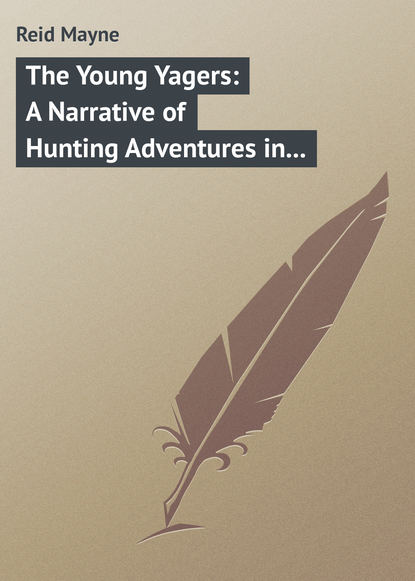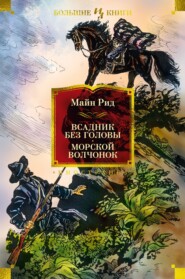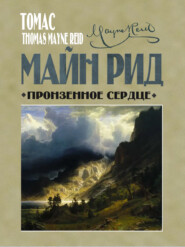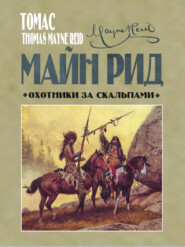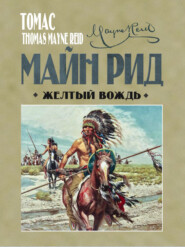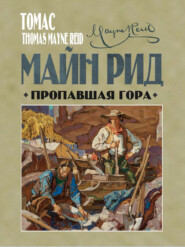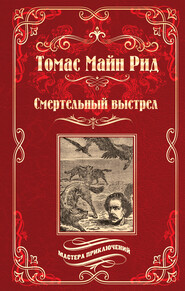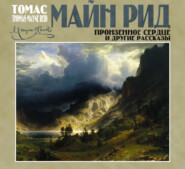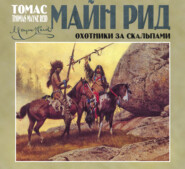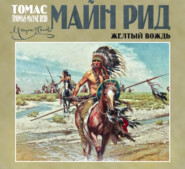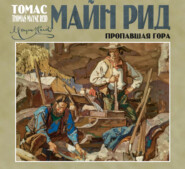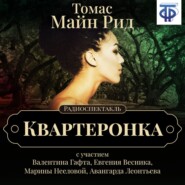По всем вопросам обращайтесь на: info@litportal.ru
(©) 2003-2024.
✖
The Young Yagers: A Narrative of Hunting Adventures in Southern Africa
Настройки чтения
Размер шрифта
Высота строк
Поля
They headed directly for the ostriches’ nest. They were not going to make a circuit for such an insignificant creature as the little fennec. They knew that it could only escape them by getting to a hole, as they had dogs that could trail and run it down go where it would. It was probable that its burrow was not very near. It had evidently strayed away from home, and “dogged” the ostriches to their nest, so as to get at their eggs. Swartboy alleged that such was its habit – that it was fonder of eggs than any other food – and that the eggs of the great bird were its particular favourites. That it was constantly roving about in search of ostrich-nests; and as these are very difficult, even for a fox to find, the fennec, when it suspects that the ostriches are laying, will follow them for miles to discover the nest – just as Hans had seen this one do.
Swartboy had given all this information on the preceding night, which, of course, explained the mystery of such a small creature running upon the trail of the great ostriches. It was not them, but their eggs, it wanted.
Now there was still a mystery Swartboy had not explained; and that was, how this animal, when it found the eggs, was able to get at their contents? The shell of the ostrich-egg is thick and strong. It requires a considerable blow with some hard weapon to break it, and how a puny creature, like the little fennec, could effect a breach was a mystery to all, but especially to the naturalist Hans. The fennec was no stranger to him. He had seen many of them in captivity. He knew something of their anatomy. He knew that their skulls were destitute of the ridge in which the temporal muscles are inserted, and that consequently they were weak-jawed animals – much more so than the common fox. It was not possible for them to have broken the shell of an ostrich-egg with their jaws. He knew that it was equally impossible for them to effect that purpose with the claws of their feet – the soles of which are covered with soft wool, as in the Arctic fox – a peculiarity considering that the fennec is an inhabitant of the hottest climes, and one quite unexplained by naturalists!
From the strength and structure of the animal, Hans believed it could no more have got at the contents of an ostrich-egg than it could have eaten its way into the heart of a bomb-shell.
Swartboy was here at fault. He only knew that it did get at the contents, white and yolk; but how he had never observed. He could not tell. He could not solve the mystery.
They had not long to wait in doubt about this matter. In less than ten minutes after, the fennec himself presented the solution before the astonished eyes of the young yägers.
When they had ridden up within some three hundred yards of the nest the little animal came under the view of all, and they pulled up to watch his manoeuvres. He was so busy about his own affairs, that he had not perceived their approach. The ground was covered with soft sand, so that the hoofs made no noise, and with all his keen sense of hearing – for he possesses that in proportion to his large ears – he had not caught a sound. He was hard at work, and never looked towards them. In fact, he was seen to raise his head at intervals, and look towards the point whither the ostriches had gone, and all his gazing was in that direction. The party had, therefore, a good view of the animal without being observed by him; and they watched his manoeuvres with interest.
Swartboy and the Kaffir held the dogs in their leashes, and all remained silent as statues.
Now what was the little fennec doing?
At first the spectators were puzzled to make out, but presently all was explained.
When they first saw him he was at a distance of several yards from the nest, and going farther from it, on the opposite side to that where the hunters had halted. His tail was towards them, and the fore-part of his body appeared to be raised as if his paws rested upon something. This something was seen to be an ostrich’s egg. He was pushing it before him along the ground, using his feet alternately, and forcing the egg to turn. This action was similar to that of some unfortunate fellow on the tread-mill, except that it was voluntary on the part of the fennec.
Now why was he rolling the egg? Did he mean to transport it in that way to his burrow? It would have been an arduous task, as it was not likely his subterranean dwelling was anywhere in that neighbourhood.
But he had no such design. His intention was to eat his breakfast on that very spot, or at all events very near it; and the spectators soon saw where his table was to be spread, for some of them now remembered an odd story they had heard of the caama, and already suspected his design.
About three or four yards from his snout lay a stone. It was a boulder of small dimensions, some twelve inches in height, but quite large enough for the fennec’s purpose. It was evident that he had a purpose with this stone, for he was rolling the egg directly towards it. Those who had guessed his design were not disappointed. When his snout was within about three feet of the stone, the fennec made a sudden rush forward, carrying the egg along by a rapid motion of his feet, until the hard shell came in contact with the harder rock.
A “crash” reached the ears of the hunters, and, looking attentively, they saw that the egg was broken into “smithereens!”
The breakfast of the fennec was now before him, and he at once set about eating it, but the hunters were hungry too, their patience could hold out no longer, and spurring their horses and letting slip the dogs, they galloped forward.
It was a short run for a fox to give. The creature had hardly made good a couple of hundred yards, before the buck-dogs threw him; and it was just as much as Swartboy could do, aided by his jambok of hippopotamus-hide, to save his beautiful skin from their jaws.
The eggs were soon collected. Those in the nest had “gone too far,” as Groot Willem had feared: some contained chicks, and others were addled. But of the ones scattered about several turned out quite fresh, so that the hunters had omelette for breakfast, as they had wished.
Swartboy showed them how to cook the eggs to perfection. This mode was to set one end in the ashes, break a hole in the other, and then with a little stick keep stirring the contents until they were sufficiently broiled. That is an omelette of ostrich-eggs.
Chapter Fourteen.
The Blauw-Boks
After all, the young yägers were not to be disappointed in a chase. If the fox of South Africa gives but poor sport, there are plenty of other animals, neither so weak-limbed nor short-winded; and one of this kind it was their fortune to fall in with on that same day, and almost within the hour.
On the other side of the mokhala grove from that on which the ostriches had been observed, lay a wide open plain. It was not a desert, although it approached so near to one, – separated from it only by a belt of timber. It was a prairie or natural meadow, the grass – perhaps from contrast with the broad brown expanse on the other side – having an extremely fresh green look.
It was a large plain, though not limitless to the view. In the distance could be seen a wood of the giraffe-acacia, or “cameel-doorns,” bounding the horizon; and several clumps of these trees, with their umbrella-like heads and feathery fronds of pale green, stood isolated upon the plain, giving the scene altogether an interesting aspect. A very park appeared this plain, with wide open pastures between its groves and coppices, many of which were of such regular forms that one would have fancied they had been planted to adorn it.
So lordly a park, such rich pastures, could not be untenanted; nor were they. There was no mansion, no house, not a trace of a human being to be seen, but for all that the plain had its denizens. Many forms could be distinguished upon or around it, both of winged and wingless creatures. Birds and quadrupeds of rare and beautiful kinds made this fair scene their home.
Over its greensward stalks the “secretary,” the true serpent-eater, hunting among the grass for his glittering prey. Even without using his wings, he need not fear any of the crouching carnivora, as his long legs suffice to carry him far beyond reach of either hyena, jackal, wild dog, guepard, or leopard. Swift is he, almost as the great ostrich itself, – so swift as to have earned from the Arabs the singular sobriquet of the “Devil’s horse.”
Not far off another tall bird stands erect upon the plain, but of very different character and habits. This is the “pauw” or “wild peacock,” – a peacock only in the phraseology of the boors, for the bird is a bustard, and the largest of his tribe – the Otis kori.
Running from copse to copse, or feeding over the plain, may be seen flocks of the pearly guinea-fowl, (Numida meleagris), whose constant chattering grates harshly on the ear, resembling the metallic clanking of machinery, or the sharpening of a hundred saws.
From tree to tree flutter gaudy parrots, green pigeons, and soft cooing doves, and over flowery shrubs flit numerous species of tiny “honey-suckers,” – the African representatives of the humming-birds. Some trees carry the pensile nests of the weaver-bird, (Ploceus), hanging from their branches like large fruits, while many of the cameel-doorns are loaded with the vast thatch-like republican dwellings of the sociable grosbeak, (Loxia socia).
But birds are not the only tenants of this fair scene. Quadrupeds, as bright and beautiful as they, haunt its verdant glades, or repose under the grateful shadow of its acacia-groves.
In a few hours’ ride one might see graceful antelopes of many species. The nimble springbok – the gazelle of South Africa – might be observed trooping over the sward, or bounding high in air either in sport or alarm – the orange “hartebeest,” and the purple “sassybe,” might be seen – the shaggy-maned eccentric gnoo, scouring the plain in circles – droves of quaggas, or of the still more beautiful “zebra of the plains,” (Equus Burchellii), might be seen too, crouching around the copses, the leopard, fair but fearful to look upon; and still more fearful to behold the tawny tyrant of the scene – the lion.
All these creatures, and many more of equal interest, might come under the eye of the traveller or hunter during a single day’s ride through that wild domain.
Thus full of life, what a contrast did this beautiful meadow present to the monotonous waste of wilderness, that stretched away from the opposite side of the grove to the far horizon!
Baulked in their projected “surround” of the ostriches – disappointed by the “poor sport” which the fox had afforded, the hunter-boys were determined not to be “choused” out of a chase. Some sort of one they would have, if it were only a brush after springboks, for these, they knew, they could find at any time. They were aware of the existence of the fine plain – the edge of which came up within a few hundred yards of their camp. They had pastured their cattle there on the evening before; and conjectured that it must be the haunt of many kinds of game. For this reason they now resolved upon making an excursion to that quarter, to hunt whatever might turn up.
They came to this determination, only after their return from the ostriches’ nest; but as they had made up their minds to it before eating breakfast, they did not off-saddle, but kept their horses ready for being mounted.
As soon as the meal was over, they took once more to their saddles and rode off, the buck-dogs following at the heels of their horses. Congo and Swartboy stayed by the camp.
They had not far to go, before coming in view of their game; and rare game that was.
They were scarce yet a hundred paces from the camp, and just about to ride out from the timber, when Hendrik, in the advance, suddenly reined up his horse, making a sign for the others to do the same. All pulled up in a breath, and sat in their saddles, gazing out through the leaves. Though still within the shadow of the grove, all had a good view of the open plain; and before them was a sight that would have warmed the hearts of older hunters than they.
Out upon the plain, and directly in front of them, was a herd of noble antelopes. They were neither gnoos, nor springboks, nor hartebeests, nor any of the common kinds that the party had already met with, and had hunted to their satisfaction. Indeed, they were of a species that none of the six had ever seen before, and they only knew them to be antelopes from the make of their bodies, the shape of their horns, and other points characteristic of these animals.
They were antelopes of large size, standing nearly four feet high, having sabre-shaped horns curving gently backward and ringed to within six inches of their tips. Their general colour was ashy grey, tinged with raven-blue – the blue tint being caused by the deep black colour of the skin shining through the hair.
Although none of the party had ever seen such antelopes before, Hans, and also the hunters Hendrik and Groot Willem, guessed what kind they were. They were of a kind that once ranged the Graaf Reinet, and even as far south as the Cape itself, though there they were never common. That was long before any of the young yägers had ever fired a gun or mounted a horse, but as these remembered having heard their fathers talking of this animal – of its blue colour, of its long curving horns, of its fine outline of form, as well as bold fierce character – they recognised those before them by the descriptions they had heard. They could be no other than blue-bucks, or blauw-boks in the language of the boors.
Hans, after eyeing them a moment, gave this as his opinion. The species was the blauw-bok, the Aigocerus leucophea of modern systematists.
Now of the group of antelopes to which the general name Aigocerus has been given there are five species – all large noble animals, and all inhabitants of South Africa, and particularly the countries adjacent to the Great Orange River.
First, there is the “waterbuck,” (Aigocerus ellipsiprymnus), which stands nearly four feet in height, is of bluish grey colour, frequents the banks of rivers, takes the water freely – whence its trivial name – swims well, is bold, fierce, strong, and dangerous, when bayed or wounded.
Secondly, there is the “takhaitze,” (Aigocerus barbatus), nearly as large as the waterbuck, but distinguished by a long beard and mane. The character of the waterbuck for fierceness and daring also belongs to the takhaitze, and both are swift runners. The latter, however, is less attached to the water, and frequents a hilly region, browsing goat-like upon the leaves of the acacia.
The third of this genus is the “roan antelope,” (Aigocerus equinus), a strong fierce animal, with horns curving backwards as in the blue-buck, but thicker, and more rapid in the curve. It is an antelope not of the plains, but a dweller in the hilly region.
The “sable antelope” (Aigocerus niger) is by far the most beautiful animal of the group. It is not many years since this antelope was made known to science, having been discovered in South Africa by a keen British sportsman. It is one of the largest of the race, standing four feet six inches in height, and carrying a pair of scimitar-shaped horns over three feet in length. Its colour is a deep glossy black or sable – whence its specific appellation – though it is white underneath with white markings about the head and neck. None of the antelopes of this group are of common occurrence even in their native haunts. None of the species can be called gregarious – that is, they do not appear in large herds, like the springboks, gnoos, hartebeests, or bonteboks – though small troops of less than a dozen – families, in fact – may be seen together. Oftener they are met with in pairs, or single individuals, and they are all scarce in the regions they inhabit when compared with the vast herds of the more social kinds.
The blue-buck is now one of the very rarest of the group, so much so that some naturalists believe it to be extinct. That is not likely. Africa is a large country.
Now all this information was furnished by philosopher Hans. He did not offer it just then – that is when they came in sight of the herd of blue-bucks; though he would, likely enough, had the others been inclined to listen to him.
But they were not. The hunters Hendrik and Groot Willem were gazing with eyes wide open, admiring the beautiful proportions of the blauw-boks, which promised them a glorious run.





